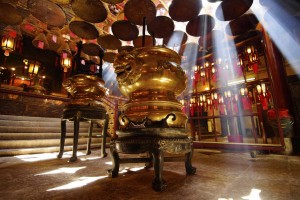When a student feels anxious before a test in China, he can go visit the Man Mo Temple. The temple was erected in 1847, and it was designed as a house of worship for the Gods of both literature and war. Historically, students in Imperial China would visit the temple before taking civil examinations.
These rigorous tests were enough to inspire dread in most people, but success meant stable work. Those who were feeling particularly anxious often went to go stand below the massive incense coils hanging from the temple.
The space is part of a larger complex of temples, which were designed to be a place of worship for many gods, not just the gods of literature and war. These places were also gathering halls, where community matters were debated and settled.
Hong Kong holds several Man Mo Temples, the most well known being Sheung Wan. Also known as the “Hollywood Road” Temple, Sheung Wan is open to the public nearly all day on most days. It was entrusted to a local hospital group, who owns and manages the property. It’s also a Grade I historic structure according to Chinese law, an honor the building received in 1993.
Tai Po, built in 1893, is located on Fu Shin Street. It was built to mark the foundation of the Tai Wo Market Town, and is another declared monument in Hong Kong. Both temples offer a place of contemplation and respite in an otherwise busy city.
About the Author: Samuel Phineas Upham is an investor at a family office/ hedgefund, where he focuses on special situation illiquid investing. Before this position, Phin Upham was working at Morgan Stanley in the Media and Telecom group. You may contact Phin on his Samuel Phineas Upham website or Facebook.

 By
By